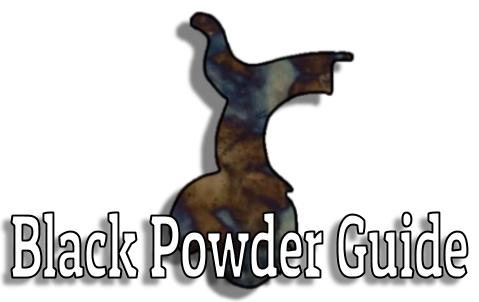One of the most exciting things about purchasing your first black powder revolver is just looking at all of the various makes and models that you see online and in the sportsman’s catalogs.
Steel framed or brass framed, sheriff’s models or full length, Colt models or Remingtons. Maybe you just want a model that your favorite character in a western uses. Maybe you just want something reliable.
Whatever path you take, you’ll eventually land at an inevitable fork in the road — Pietta or Uberti.
Both are manufactured in Italy, and both are reproductions. Uberti sells many of its firearms under the name Cimarron and Pietta sells many of its under the name Traditions. Both create Colt and Remington reproductions for black powder enthusiasts.
This is all good and well, but you’re here to find out what you can expect when purchasing one versus the other.
In this article I’ll touch on the major considerations and what each brand brings to the table. If you just plan on skimming this article, I highly recommend paying attention to the last two sections that deal with “defects and problems” and “should I buy a Uberti or Pietta” so that you will be aware of the major headaches. There’s one defect in there that will make it so that I NEVER buy from one of these companies again!
Just know that if you’re new to black powder revolvers that BOTH brands will typically send you a revolver that is at 85% of its full potential. It may be ready to fire, it may not. It may have a great fit and finish, and it may not. The problems can usually be corrected. Like I said, you’ll receive a “B” grade revolver from Pietta or Uberti and it’s your choice to make it an “A”.
You will almost always need to do some gunsmithing yourself in order to get your revolver where it needs to be for full reliability and function.
*** As a quick disclaimer, I only possess Colt reproductions by Uberti and Pietta, as I am partial to the look and feel of the Colts. In time I’ll purchase a Remington reproduction and update this article accordingly.
For an in-depth article that was dedicated to my experiences with Pietta and Uberti, feel free to click on those links to open them in a new tab.
| Catagory | Winner |
|---|---|
| Price | Pietta |
| Adherence to Historical Accuracy | Uberti |
| Overall Shooting Experience | Uberti |
| Aesthetics & Fit and Finish | Pietta wins on function, Uberti wins on looks |
| Reliability | Uberti |
| Accuracy | Tie |
| Worst Defects and Problems | Pietta |
Price: Pietta Wins Over Uberti
The first question that you’ll likely have, besides the quality that you’ll receive between each brand, is the price difference between the two.
As a general rule, Pietta revolvers are a cheaper option by about 15% for the same comparable model that is produced by Uberti.
For example, an 1851 Colt Navy replica from Pietta will run about $315 (before shipping and taxes), and the same model will cost $375 from Uberti.

The price range for a Pietta black powder revolver (depending on the model) is $295-$450 as of January 2022. Conversely, the range for a Uberti (depending on the model) is $375-$490.
Pietta generally offers more brass framed options which are cheaper to make (and cheaper to buy) but are inherently weaker firearms over time as the frame will eventually stretch with every firing of the gun.
Prices have risen by 15-20% across the board for every model from both Uberti and Pietta since 2020, and this is certainly due to the global events over the last two years.
My 1851 Navy from Uberti was $295 (on sale — normal price was $315 if I remember correctly) when I bought it a little over a year ago. That same revolver is now $375.
Check out Dixiegunworks.com for prices and availability (not an affiliate link). Black powder revolvers (not the conversions which can shoot metallic cartridges) are considered antiques (even the replicas) and are not considered firearms for FFL purposes. Therefore, they can be shipped to your house in most states which don’t otherwise prohibit it.
Adherence to Historical Accuracy: Uberti Wins
I’m not an expert in this field, but from my research it is pretty clear that Uberti wins when it comes to adhering to historical accuracy with the majority of their models with regards to the actual build of the gun and the models offered.
Pietta has been known to offer revolvers with a grip design that was not true to the original models and it featured a longer “tail” on the back strap portion. I don’t believe they still do this but I could be wrong. When I compare the grips from my Uberti and Pietta, they appear identical.
Pietta also offers many models with brass frames that never actually had a brass frame in historical records. This is undoubtedly done to cater to a customer base who don’t want to break the bank when testing the hobby.
Pietta even offers models in calibers that they were never manufactured in during the 19th century. A common model sold by them is the 1851 Navy in .44 caliber. It was only ever made in .36 caliber from all of my readings.
The brass framed models are typically sold under the story that they were Confederate models during the American Civil War since brass was easier to come by than steel in the south. This may have been true for a few models (that were produced on a very limited scale during the war) but this does not hold true for all of the models that are offered by Pietta.
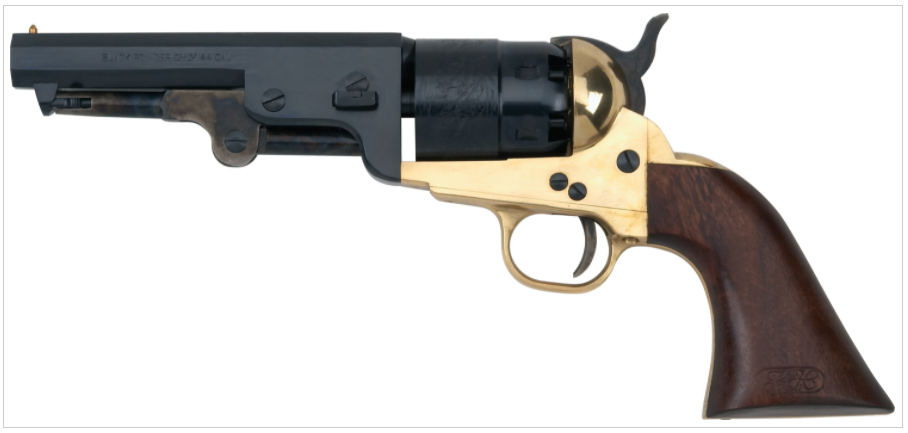
A key example above is the Pietta 1851 Colt Navy Brass Framed Sheriff’s Model (shorter barrel) chambered in .44 Caliber.
This gun never existed. 1851 Colt Navy revolvers were issued in .36 caliber. They were steel framed. They were never cut down to a shorter barrel length during official production (gunsmiths may have done it after the fact).
It is best to research the particular model that you plan on buying prior to purchase if you’re concerned with historical accuracy. There is so much information out there (especially in black powder forums) on every obscure make and model!
Overall Shooting Experience: Uberti Wins Over Pietta
I’m assuming you’re buying a black powder revolver in order to shoot it at some point. The shooting experience is something more intimate with a black powder revolver than you’ll experience with any modern firearm.
You must load the powder in each chamber, then a wad that you likely made yourself. Then you firmly press in a lead round ball that you also might have made yourself. You then cover the lead round ball with a grease that you also might have made yourself. When that is all done, you must then cap each nipple before the revolver is ready to fire.
When the gun goes off, there’s an invigorating smell of black powder in the air that just makes the sport so much more fun than shooting modern ammunition — but the cleanup process is definitely where the fun ends!
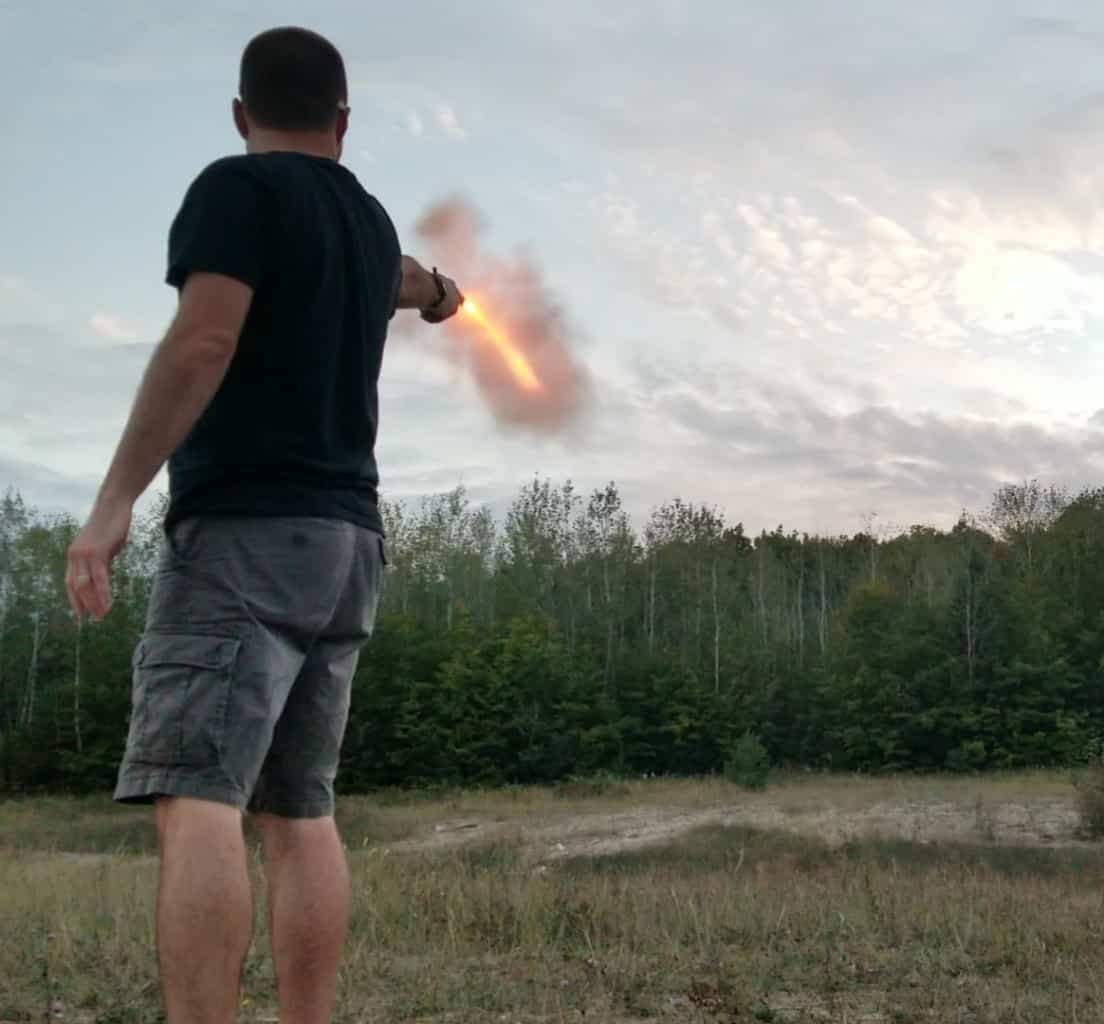
If I have to award the winner of the best shooting experience it would go to Uberti, and that has nothing to do with the results on the target.
There’s just something about how a Uberti made revolver feels in your hand versus a Pietta. If I had to narrow it down to why I feel this way, I think it comes down to the following:
- The Grip
- The Hammer
- The Action
Some of these points definitely fall under the next section, but when combined they really make all the difference at the range.
First, the grip of the Uberti is far superior to the Pietta. If I had to compare them to something you might be familiar with, imagine picking up a $600 Ruger Single Six .22lr revolver and then picking up a $125 Heritage Rough Rider .22lr afterward. They both function great, but there’s a way that they feel in your hand and you know why one is at a higher price point.
By grip, I don’t mean the shape (though I do believe on older Pietta models did have different grip shapes), I just mean how the wood fits to the back strap and how it marries up to the frame. Uberti is flush, nothing stands proud, and it just feels like it belongs in your hand.
I could see daylight between the wood and the frame on my Pietta, and the wood was standing proud of the back strap in the back where it presses into your palm. It’s doesn’t detract from the functionality, but it certainly is noticeable in the hand. I’ve tried to fix the issue, but haven’t seemed to correct it yet. I’ve given up for the time being.
Second, the hammer on the Uberti feels more reliable for shooting than the Pietta. By this, I mean where your thumb comes into contact with the hammer itself to draw it back for each shot.
The Uberti has deeper cuts that are crisscrossed and feel like you could strike a match on them. The surface created by those cuts makes it clear when your thumb contacts the hammer that there will be no slipping and that the purchase you have on it is solid.
The Pietta has a hammer with shallow, lateral slits cut into it and with sweaty hands in the summer it’s about as good as nothing.

Finally, the action itself is way slicker on my Uberti than it is on my Pietta and I am using the same internal aftermarket parts (trigger-bolt springs) from the same aftermarket suppliers, and I have done the same internal work on both brands.
Perhaps this one is the most subjective and the next Pietta I would have gotten would be slicker than the Uberti, but I’m just going off my experience. The hammer pull and the sound of the clicks just sound clean and elegant with the Uberti. Uberti meets my preconceptions about what a single action six shooter would sound like in the Old West. The Pietta just doesn’t hold a candle to it and sounds muffled and like a different metallic pitch altogether.
Aesthetics & Fit and Finish: Pietta wins on Function, Uberti Wins on Beauty
Now that I’ve dragged Pietta through the dirt, I’ll give it a little bit of praise.
Straight out of the box, Pietta wins as far as function and being range ready (with one MAJOR caveat to this statement listed in the “Defects and Problems” section at the end). On the flip side, Uberti wins in the beauty category straight out of the box.
One thing that Pietta does great when compared to Uberti is getting the correct fit between the barrel assembly and the frame itself. The gap between the cylinder and the barrel assembly is spot on from the factory and you won’t need to do any gunsmithing.
I had one Uberti (1851 Navy) that REALLY messed this up with an egregious cylinder gap, but I had another Uberti (1849 Pocket Pistol) that got it right.
When I scoured the internet forums, I see that this is not an uncommon of problem with Uberti, but Pietta gets it right.
The problem stems with Uberti making their arbor pin (that runs through the cylinder and into the barrel assembly) too short for the recess in the barrel assembly. Ideally, it should bottom out and the tolerances should be such that the barrel will mate up to the frame and there will be approximately 0.004″-0.006″ of space between the cylinder and the barrel’s forcing cone when the cylinder is pulled backwards towards the hammer.
Since there arbor pins are too short for the recess, this leads to inconsistencies with all the points of contact and can lead to issues with a large cylinder gap. An excessive cylinder gap will cause you to lose velocity as the burning powder comes jetting out from the sides of of your revolver since there’s too much of a space between the cylinder and the barrel. This can also lead to an increase risk of a chain fire (in my opinion).
The functional specs of the Pietta, right out of the box, made it range worthy compared to the functional specs of both of my Ubertis. Though my cylinder gap was fine with my Uberti 1849, the timing was WAY off, but we’ll get to that in a bit.
The Pietta really drops the ball with the aesthetics in regards to the overall fit and finish. The wooden grip is atrociously fit onto the back strap, the wood stain and selection is drab with a monotone grain and a dark satin finish.
The manufacturing stamps are also located on both sides of the barrel on the Pietta. This makes it reminiscent of a high end cap gun that I would have played with back in the 80’s. It’s cheap looking and is the primary reason why I will NEVER buy another Pietta again in the future.
If nothing else, I want a cool replica gun that I can shoot but also put on display as a conversation piece. A Pietta screams “CHEAP!” when anyone looks at it because of those “BLACK POWDER ONLY” and “MADE IN ITALY” stamps, despite everything else that they might get correct.
Uberti has the decency to hide their manufacturing markings under the barrel and between the loading lever. You’ll never see them unless reloading.
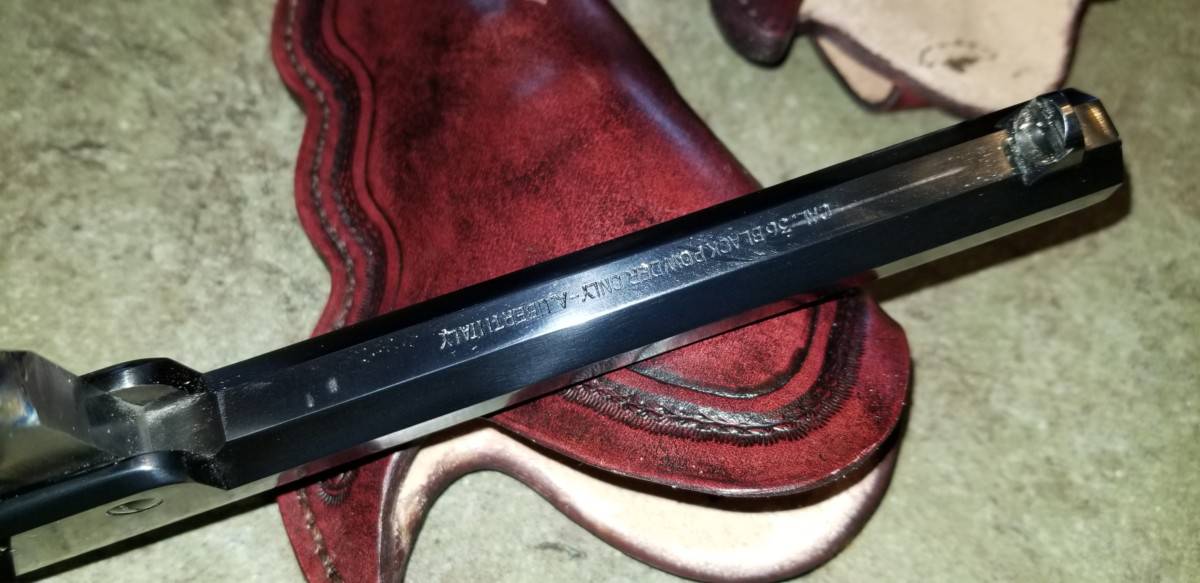
Because of this, light can glint off of the entire length of the barrel without any eye sores.
Uberti also takes the time to crown their muzzle to protect it from any accidental dings or drops. This is something that Pietta does not do on any model that I’ve ever held.

The Uberti grip is amazing. The wood selection is great with a nice grain that has character, the stain selection is great, and the semi-gloss at the end brings it all together. Better yet, it is perfectly flush and true to the back strap and to the frame. The wood doesn’t snag your skin, and you won’t see daylight between the grip and the frame when looking at the revolver sideways.


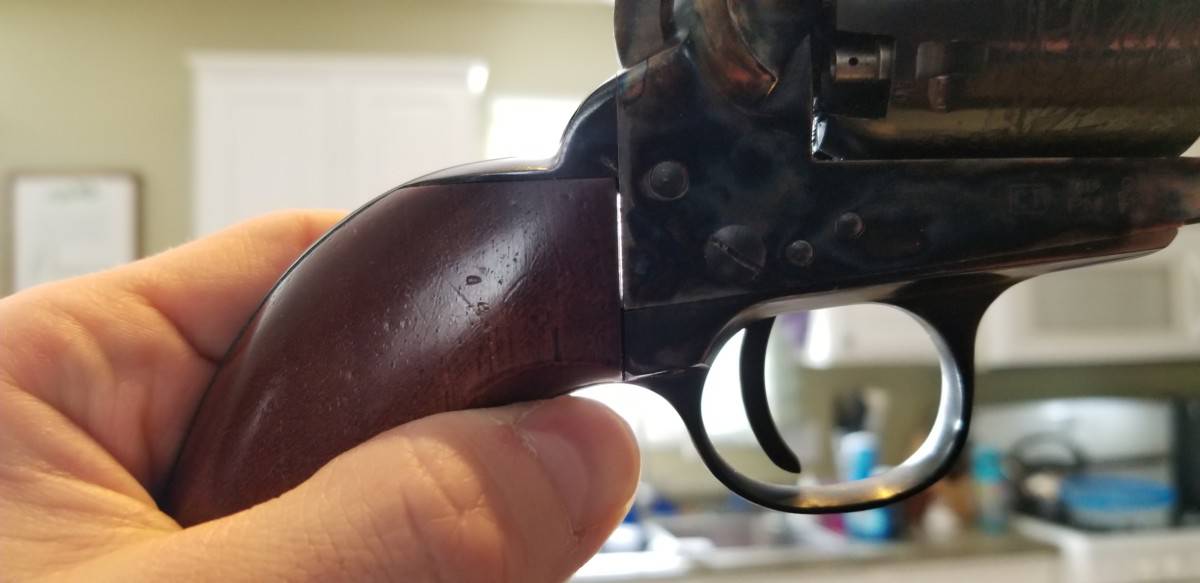
The color case hardening finish is great on both but I’d have to say that Pietta does a better job aesthetically, as it just has more contrast, flash, and character. The Uberti color case hardening is rather subdued and dull. It’s not ugly, by any means, just not as memorable as Pietta’s.
Holding it in the hand, Uberti wins. It just feels more solid to me, your hand will want to keep holding it, and I appreciate that it doesn’t advertise itself as cap gun with the writing all over the barrel.
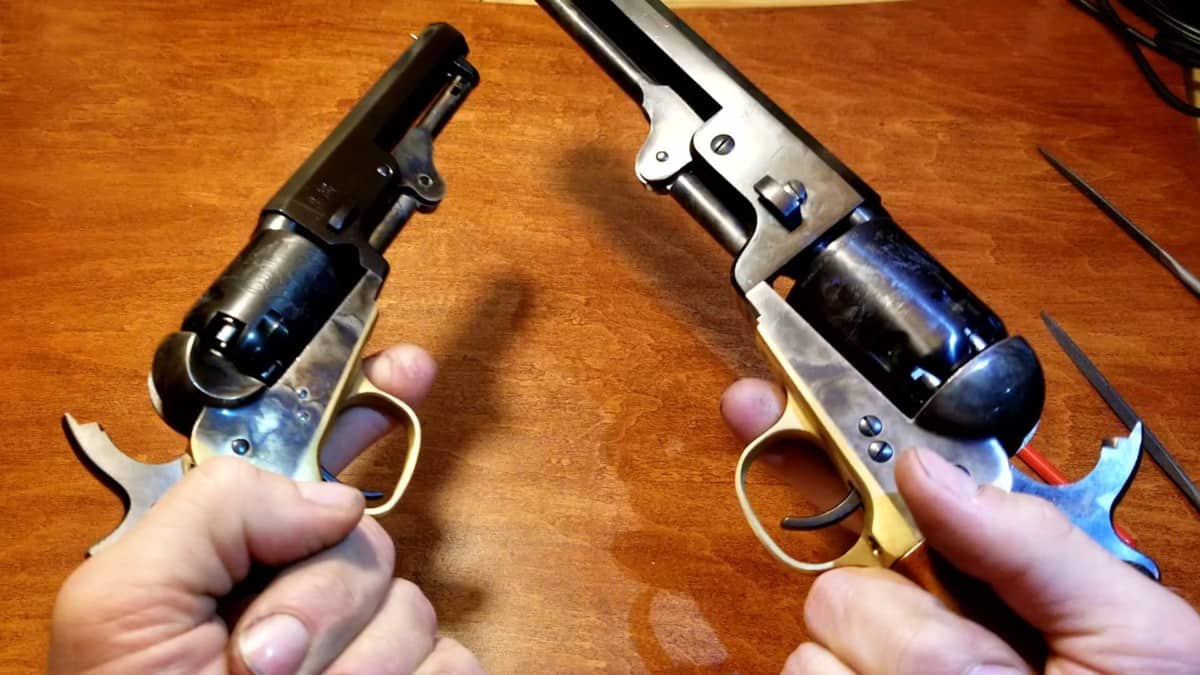
To sum it up, Pietta is like a drab looking horse with a saddle that already knows how to work but just needs you to put horseshoes on it before riding. Minimal prep work.
Uberti is a beautiful looking and determined horse that doesn’t come with a saddle and isn’t broken yet for riding. There’s a lot more potential in it than the other one, you just need to do a lot more work before taking it out for a ride.
Reliability: Uberti Wins
I have never fired my Uberti or Pietta with the factory cones (nipples), with the original trigger-bolt spring, and without having slicked up the action first.
On ALL of my black powder revolvers, I have SliXshot nipples installed, Wolff trigger-bolt springs (except the 1849 Pocket because Wolff doesn’t make it), and I have followed the direction of Duelist1954 on Youtube when slicking up the actions.
Because of this, they both are now very reliable, considering they are based on mid 19th-century technology.
***I discovered a reliability issue after posing this with regards to Pietta and it is discussed in the last two sections of this article.
I’ve fired over 150 rounds with my 1861 Navy Pietta and I can recall only 1 cap jam (and it was when I was experimenting with beeswax on the nipples to aid in waterproofing it). I do NOT tip my barrel up either in between shots. I’ve never had a round fail to fire.
I’ve fired my 1851 Navy Uberti about 100 times and I don’t recall having a cap jam. I also have not had a round fail to fire.
I’ve fired my Uberti 1849 Pocket pistol only about 2 dozen times at the present time and also have not had any issues.
Because of this, they all tie in this category when it comes to shooting in a sterile environment at the range.
If you’re looking to take these guns out into the field, then Uberti wins without a doubt due to the reasons that I give in the last two sections of this article.
I honestly thought I’d experience far more problems (failures to fire and cap jams especially) when shooting black powder revolvers, but it surprisingly hasn’t been the case.
I cannot recommend enough that when you purchase your first revolver, also purchase the aftermarket trigger bolt spring and the SlixShot nipples as well. Take an hour or two and slick up the action as well by following the video below. If you click on the link for the spring, select “EMF” for Pietta models and “Uberti” for Uberti. None of the links are affiliate.
I followed the advice of using JB Weld to fill in the notch on the hammer to prevent it from sucking caps and dropping them into the action, but I found that after a couple dozen shots the JB Weld simply fell out.
Instead, I have used a file to round off all of the 90-degree angles and haven’t had a problem with it sucking caps.
Accuracy: Uberti and Pietta Tie
Both Uberti and Pietta tie as far as accuracy.
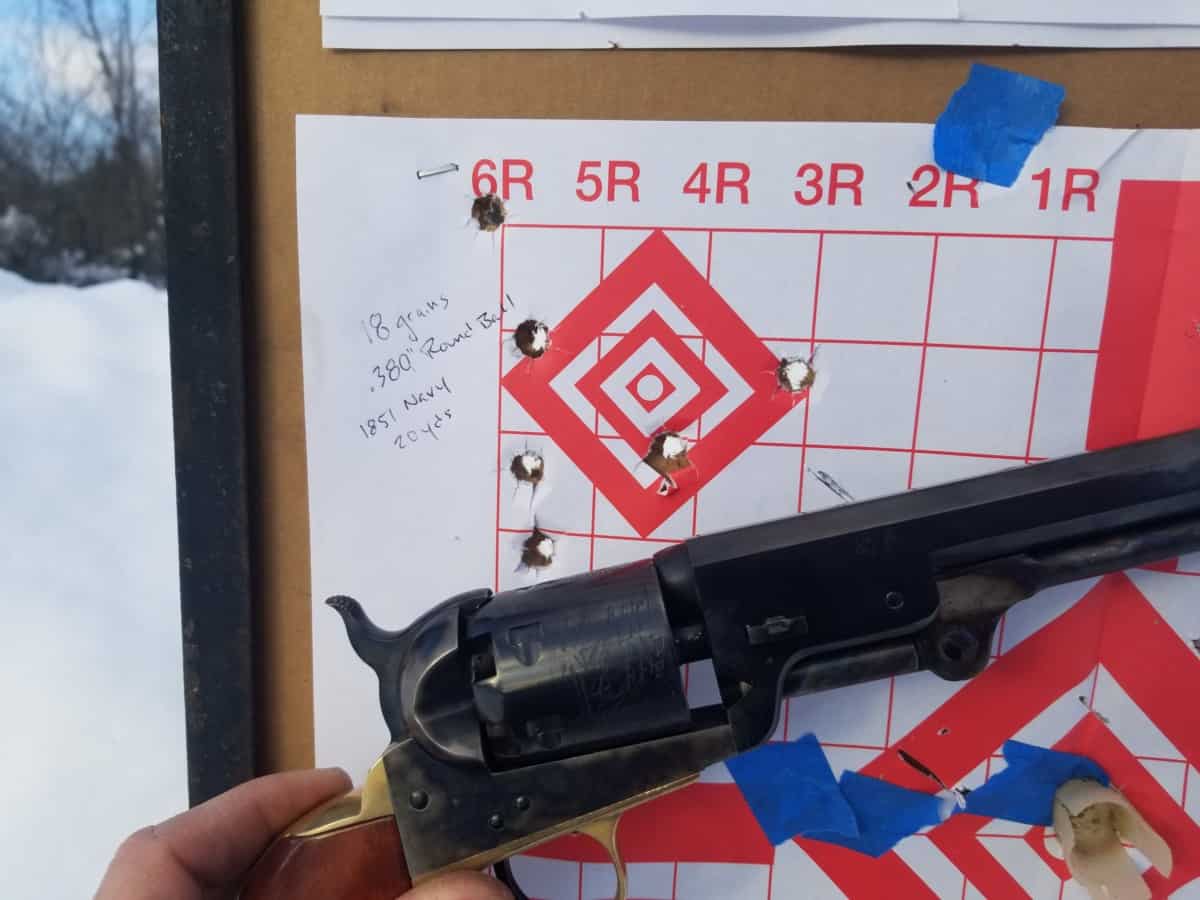
I have seen slightly better groupings with the Uberti at longer distances, but I attribute that to the length of the barrel and the longer sight picture of my Uberti 1851 Navy over the Pietta 1861 Navy Sheriff’s model (shortened barrel).
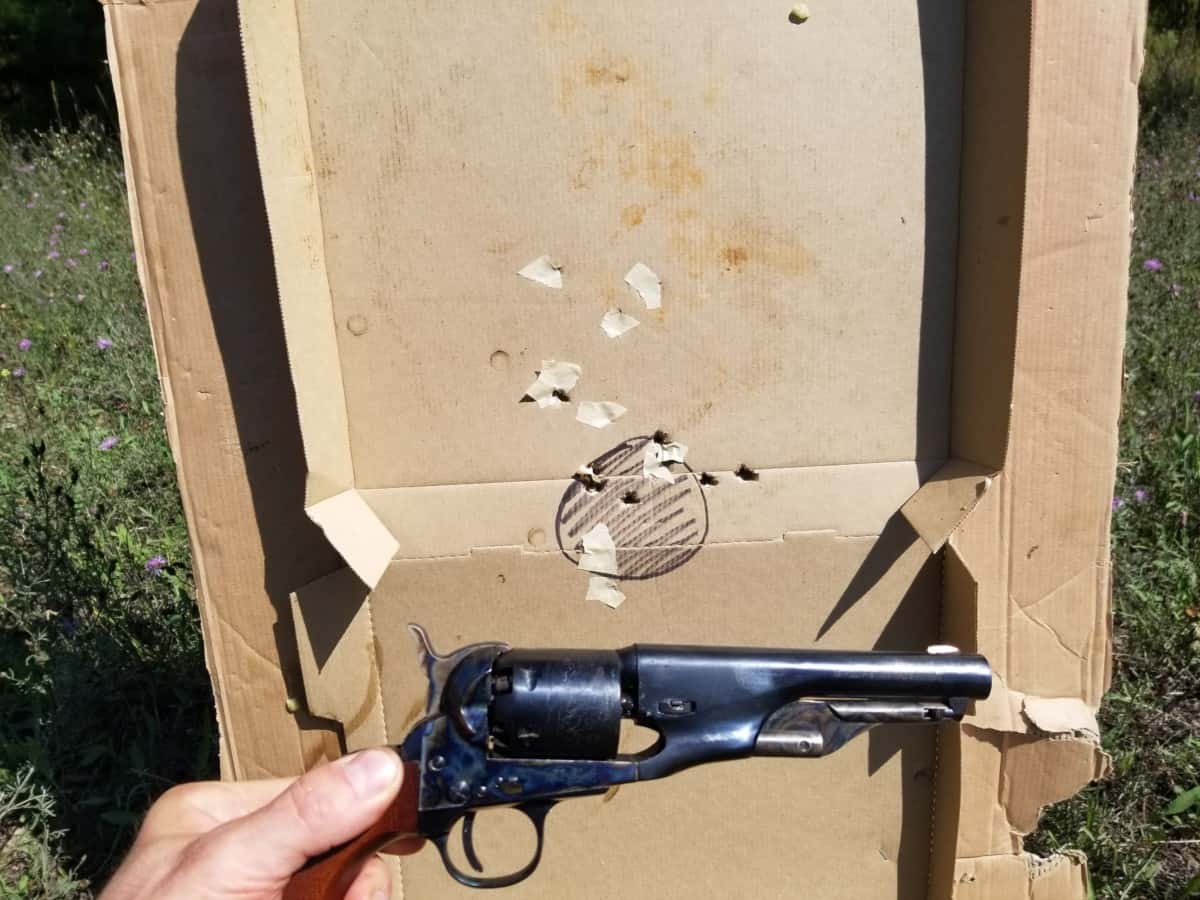
I don’t have any consistent flyers and I have numbered my chambers so I would know if one was bored out improperly during manufacturing.
When it comes to accuracy, both Uberti and Pietta are fine choices.
Keep in mind, if you’re new to cap and ball revolvers, the originals and replicas that are based on the originals were all designed to shoot point of aim at about 70 yards or so. The sights were designed for fighting during the American Civil War, where you would stand in lines across a field from each other and hurl lead back and forth.
The old adage of “Aiming for the belt buckle” and hit the heart is applicable for short ranges with these firearms.
Worst Defects and Problems: Pietta Sneaks the Win from Uberti in a Photo Finish
This is where I could really get on a rant. Pietta takes this title, hands down, uncontested — but it’s not because Uberti wasn’t trying!
Right out of the box, both of my Uberti revolvers had functional issues that had to be addressed prior to shooting.
My Uberti 1851 Navy had an egregious gap between the cylinder and the forcing cone of the barrel assembly. I’m not talking a sliver of light from the width of a piece of paper, I’m talking a few pieces of paper in width.
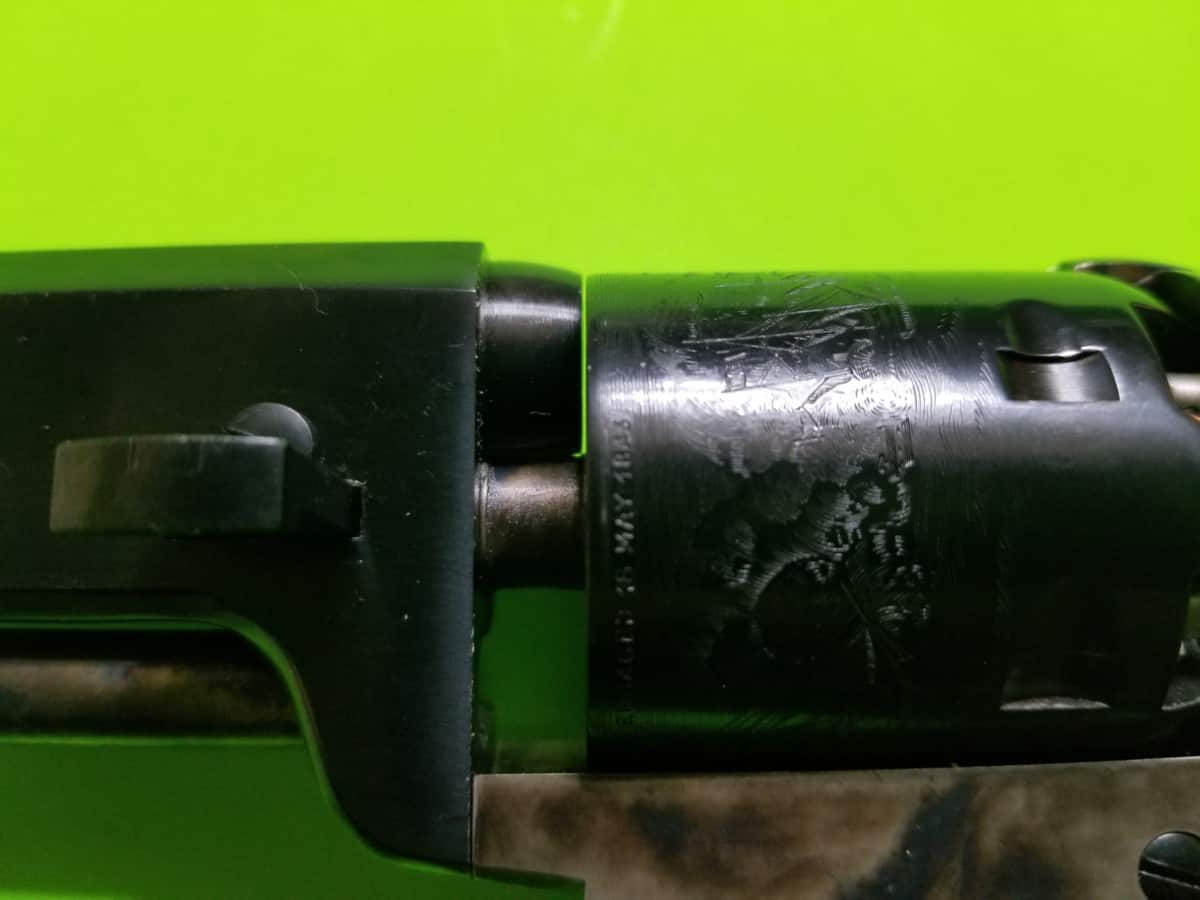
Such a cylinder gap (end shake) will lead to a reduction in velocity as burning powder flares out of that gap and fouls up your entire firearm. The flaring out of all of that burning fire is also an increased hazard for chain fire.
It took a whole day of research (lots of people complaining about this issue with certain Uberti models in the forums), two trips to the hardware store, and hours and hours of tinkering to get this problem fixed. It should have never been a problem if Uberti was doing proper quality control and had a proper fit between the arbor and the barrel assembly.
As far as my other Uberti, my 1849 Pocket Pistol’s cylinder would over-travel by 1/4″ if you pulled the hammer back quickly. Essentially, the timing was off and the bolt that should lock the cylinder in place would not pop up fast enough to engage the cut out in the cylinder until it had already passed. You’d have to pull the hammer back and then manually turn the cylinder back into alignment until it clicked.
Again, I had to research a fix for this problem for the better part of a day and then spend hours and hours fixing it. I would have to disassemble the firearm, sand down one of the fingers on the bolt that rides on the cam of the hammer for several passes, reassemble, test, and repeat… over and over again until I got it right. If I removed too much metal, I’d have the reverse problem and would then need to purchase a new bolt and wait for the better part of a month to receive it.
This is a problem that should have never occurred and were a problem with the manufacturing process right from the start. I’ve even seen this problem occur in other people’s YouTube channels when reviewing this pistol, so I know I’m not alone.
Pietta will draw my ire for what happened within 2 minutes of unboxing it. It was my first black powder revolver and I was so excited.
After I wiped off the storage grease, I started gently pulling the hammer back and slowly letting it down. Nothing crazy, nothing abusive. After about a dozen times of doing this, the action ceased to work. The cylinder would just spin freely and the hammer would not work.
The Pietta trigger-bolt spring had snapped in half after a dozen uses.
The factory trigger-bolt springs from both Pietta and Uberti are extremely cheap (as far as quality) and they will break on you. Do yourself a favor and order new springs for your corresponding revolver from Wolff gunsprings. Again, select “EMF” for Pietta and “Uberti” for Uberti. These springs are made of piano wire (or something similar) and will never break for their intended use. These springs are too large for the 1849 pocket pistol.
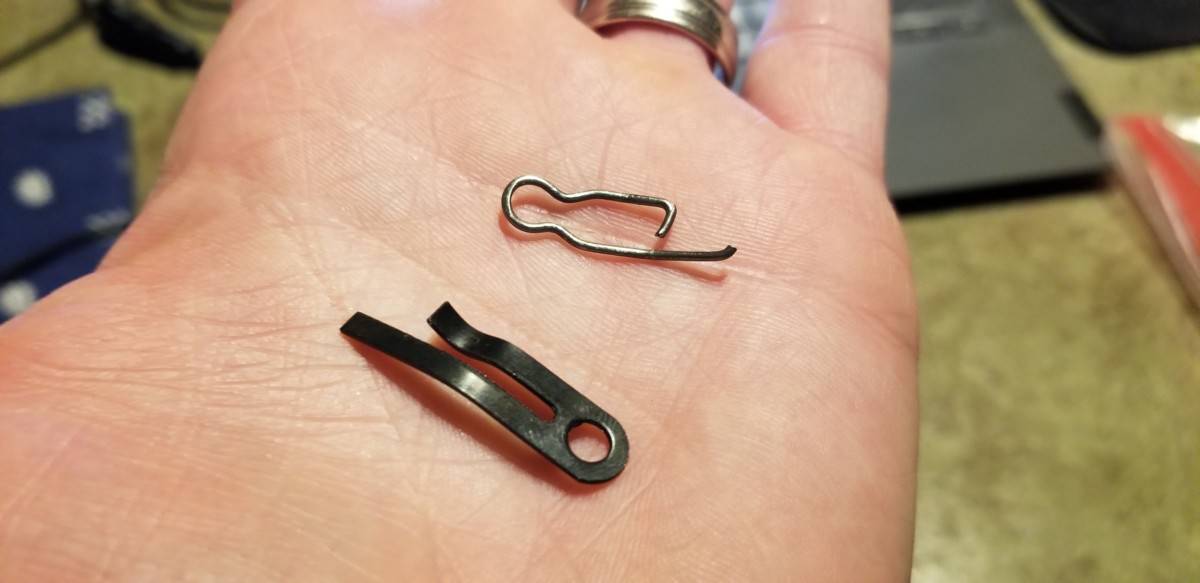
Luckily for me, a broken trigger-bolt spring is an easy fix. Once the part was replaced with a higher-quality, aftermarket part, then it was ready for the range. No real gunsmithing needed at all.
Also, my Pietta’s hammer would fail to pull back every 20 attempts or so. To make a long story short, the spring that is attached to the hand had play in it and was easily moved in a lateral motion (there should be no lateral motion for it). It would catch on something internally until I dripped a little solder on it at the connection point and filed it down flush.
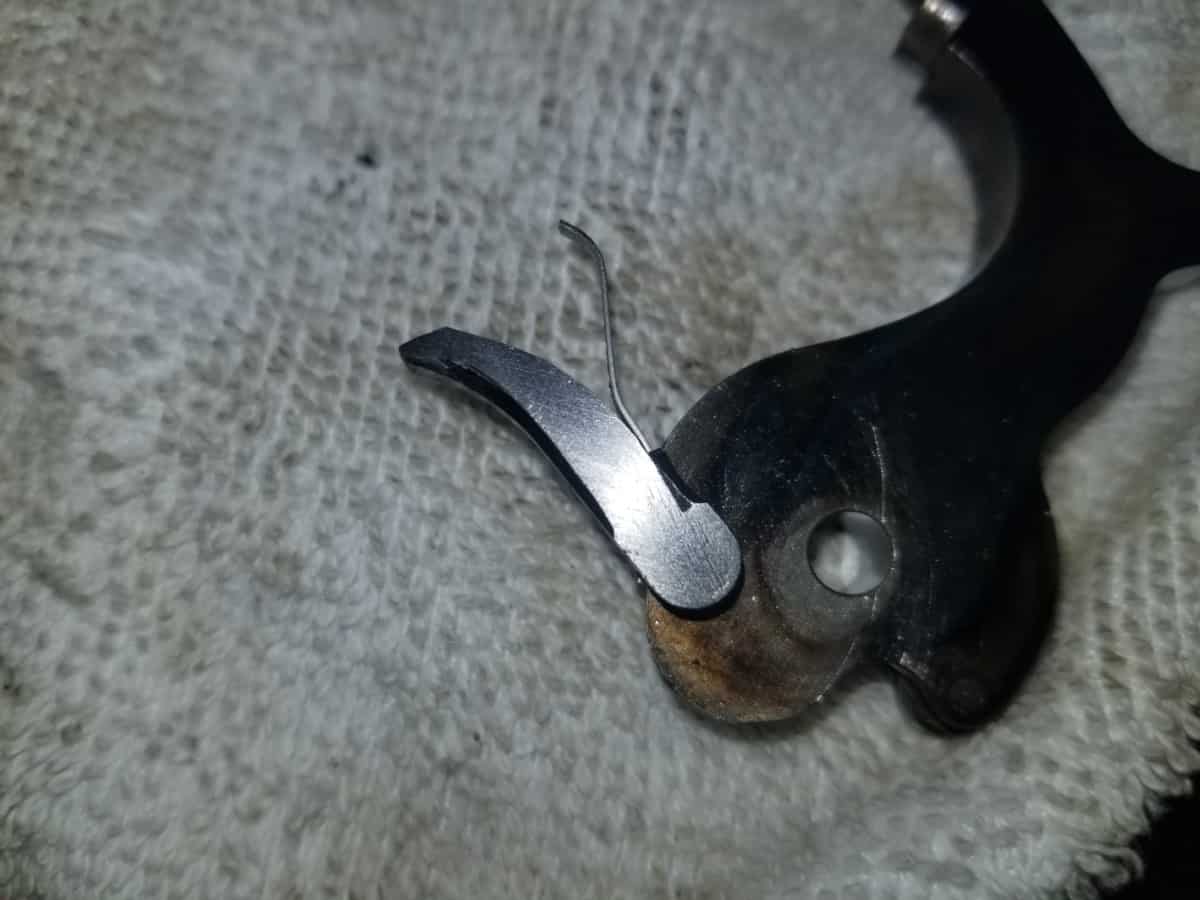
Again, cheap internal parts seems to be a consistent theme.
Both Pietta and Uberti will come with cheap trigger-bolt springs, extremely soft screws that will strip or get gnarled up with any slip of your screwdriver, and will require some slicking up internally to reach their full potential.
Also, after reading tons and tons of forums in my quest to fix certain problems with my firearms, I’ve noticed a common complaint by users that Uberti uses softer steel than Pietta. I haven’t seen any proof of this, but I haven’t tried hard to research it either. It’s just something worth mentioning and you can do your own research if that’s a concern of yours.
Finally, the reason that I will NEVER buy another Pietta again is due to the bullet creep that occurs in the cylinders upon recoil or any shaking of the gun. Yes, you read that right. The bullets will creep out of the cylinders (at least to the very end of the cylinder after you’ve rammed them down).
This will cause a weak and delayed discharge since there will now be a big air pocket and the powder will no longer be compressed. If the round balls extend past the cylinder face, then they will bind up the action when they strike the forcing cone as you pull the hammer back.
The problem once again lies with the cheap manufacturing processes of these companies, but Uberi gets this one right.
As you can see from the picture below, I loaded the Pietta cylinder and pressed the round balls down as far as the loading lever would allow. With the revolver in hand, I gave one shake downwards with it like I was LIGHTLY trying to use it as a whip.

I immediately took the cylinder off and took a picture. As you can see, 5 of the 6 round balls have moved right up to the cylinder face itself. When I shook it again, 4 of the 6 extended well past the cylinder face and were halfway sticking out.
I have cleaned out the inside with hot water and then a solvent to ensure it was not because of lubrication. I even ordered a $40 0.390″ round ball mold and cast some larger round balls (I normally use 0.380″) and that didn’t change anything. I have also used a tapered grinding stone and (by hand) tried to gently remove any burrs without any luck.
The issue is the improper factory chamfering of each of chambers of the cylinder. The face of the cylinder is a narrower diameter than the inside of the cylinder itself. This could be due to a burr that can’t be seen, or due to a wobble of the machine as it drilled out each chamber.
So even though I cut a good ring of lead on the cylinder face when loading, once the round ball gets past the burr of the chamfering it is now undersized instead of the same size as the inner walls of each of the chambers.
Either way, the fix is likely probably half as expensive, if not as expensive as the firearm itself and will need to be professionally done to not make the problem worse.
I cannot trust this firearm to not malfunction if I were to need it for anything more than in a sterile shooting environment where it is loaded and then immediately fired without performing any activity with it.
When I tested both of my Uberti revolvers to the point where I was making a whipping action with them as hard as I could and even dropped on their barrels on a carpeted floor from 12″. Not a single round ball left its position which means that the cylinders are uniform in diameter.
If I had to trust my life on one of these two brands, it would be Uberti without a doubt because of this issue… and after fixing all of the other problems Uberti came with, of course.
***If I end up finding an DIY solution to this problem I’ll be sure to update this post and link to how I fixed it.
Should I Buy a Uberti or a Pietta?
When it comes down to it, you’re going to have to make a decision between either Uberti or Pietta (or their Cimarron and Traditions lines).
The “Biggest Let Down” and “You Get What You Pay For” award goes to Pietta. The cheap internal parts that break after unboxing, the poor fit and finish, and the inconsistent chamber wall diameters have all led to this gun being nothing but a problem. Sure, I fixed the springs with ones that won’t break, and got the action to be reliable, but unless I shell out hundreds of dollars to a gunsmith and likely wait for months for it to get finished, I cannot recommend this gun due to the round balls that won’t stay in place.
To be fair, this gun has performed very reliably in sterile conditions at the range. However, if I had to load it, then hike a few miles and go to shoot, I’m sure that I would have misfires, hangfires, or underpowered shots due to the round balls working their way forward from the shaking.
Piettas will save you some money upon purchase when compared to the same model Uberti, and you will see fewer technical problems initially than Uberti with the functional aspect of things. In my eyes, Piettas will never be wall hangers. Aesthetically, they just don’t hold a candle to a Uberti and I just cannot get over the stamped manufacturing marks all over the barrel and how they cheapen what otherwise would have been a very acceptable looking firearm.
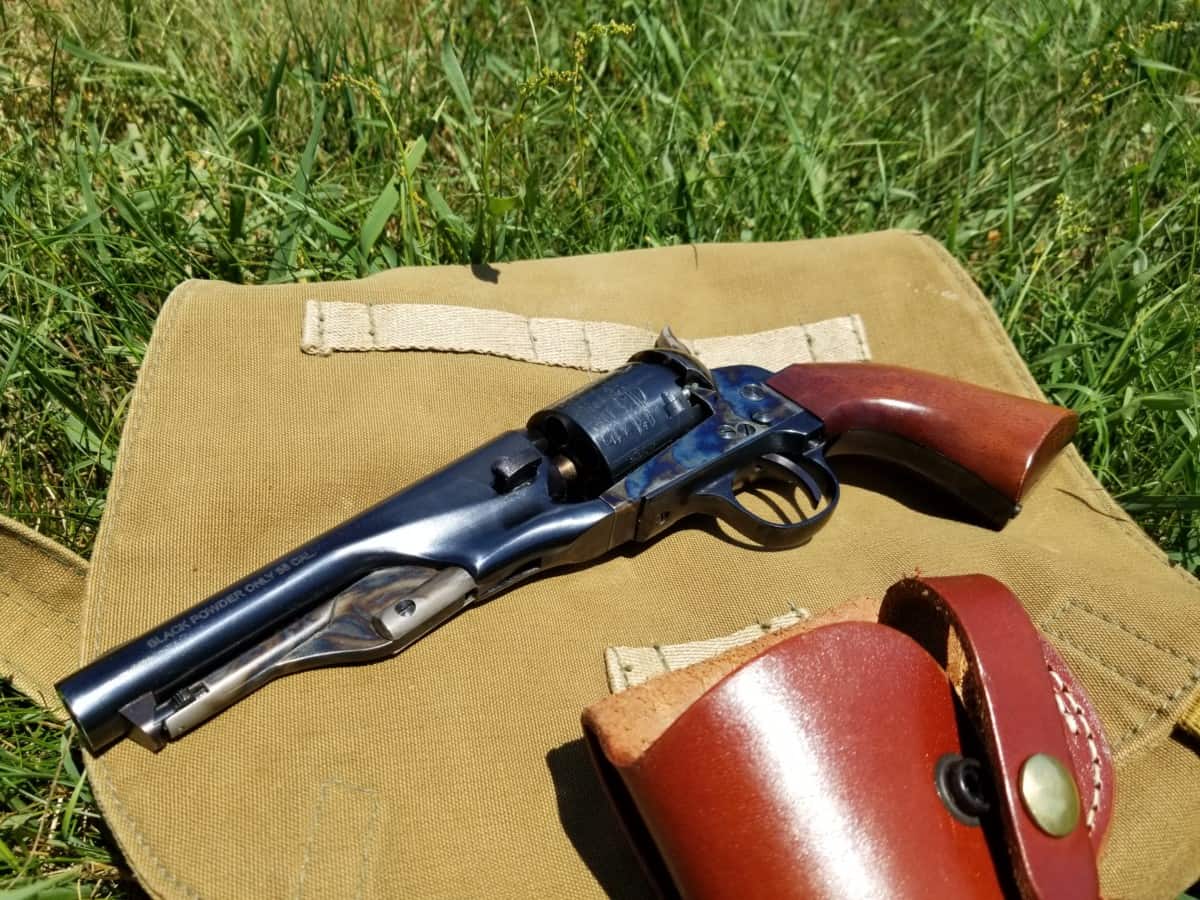
If I had no interest in doing any gunsmithing and if I didn’t really care if my revolver was a display piece, I would go with Pietta — as long as I was only shooting at the range where I load and then immediately fire the firearm. I would not trust this gun in the field due to the bullets that won’t stay seated in the chambers.
Uberti wins the “Most Potential” award and has beauty built in but is lacking on the functionality part. These pistols can be made to work just as reliably as a Pietta, you might just have to work for it and do a lot of troubleshooting (unless you’re blessed enough to not get a lemon).
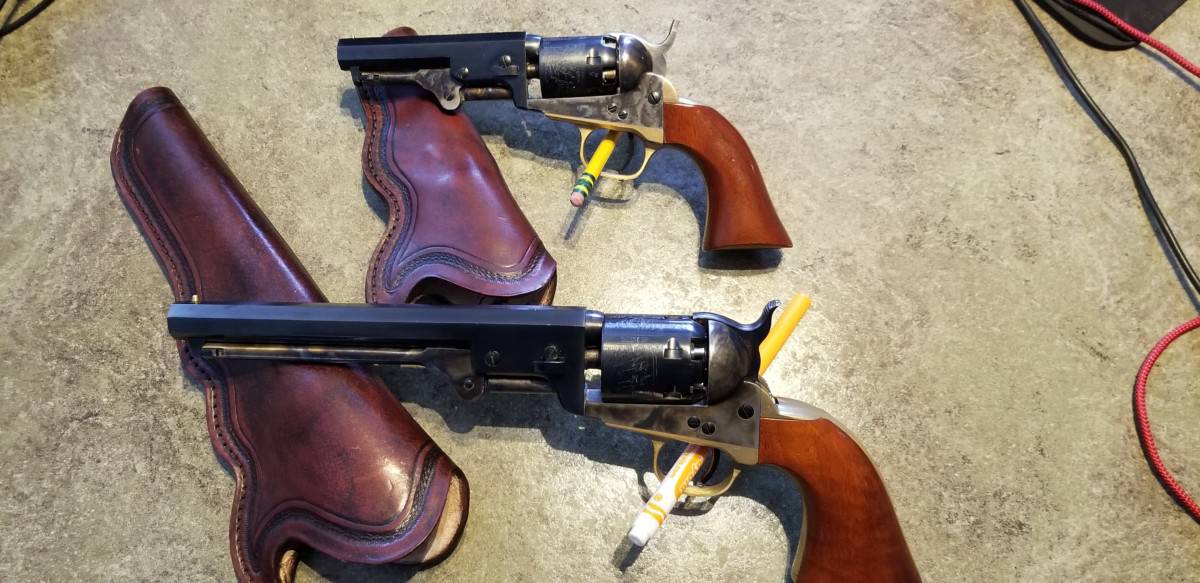
Again, just as with a Pietta, make sure to swap out the nipples with SliXshot stainless steel ones, and swap out the trigger-bolt spring.
They’ll cost a bit more ($50 or so for a comparable Pietta model) but will offer a crowned muzzle, a flawless wooden grip, uniform chamber wall diameters for bullet retention, a better sounding action, and won’t look like a cheap toy with all of the stamping all over the barrel.
If I had some confidence in some basic gunsmithing, a willingness to do some troubleshooting, and wanted a fine work of art that I could be proud of when all was said and done — I’d go with a Uberti.
Personally, I fit the previous statement. I plan on buying Uberti revolvers from here on out, despite the quality flaws upon purchase. I am confident I can bring them up to the same functional quality as a Pietta and I appreciate how they look on display.
I also can rest easy knowing that the act of walking or running won’t cause my round balls to work their way out of the cylinder!
Both brands, in my opinion, arrive at 85% of their full potential and almost border on what I’d consider a “kit gun” with that I’ve had to put into them. At the end of the day, I’d rather spend my time working on a kit gun that will look better in the end if the functionality between the two will be the same and the bullet retention in the cylinder will be better. That’s why I’ll go with a Uberti every time from now on.
